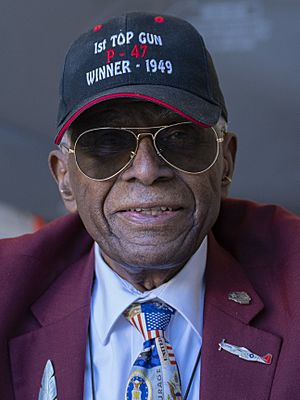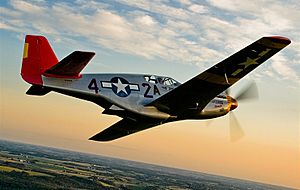James H. Harvey facts for kids
Quick facts for kids
James H. Harvey
|
|
|---|---|

Harvey in 2022
|
|
| Born | July 13, 1923 Montclair, New Jersey, U.S. |
| Allegiance | United States |
| Service/ |
United States Army Air Force (1943–47) United States Air Force (1947–65) |
| Years of service | 1943–1965 |
| Rank | Colonel |
| Unit | 332nd Fighter Group |
| Battles/wars | World War II Korean War |
| Awards | Distinguished Flying Cross Air Medal (11) Congressional Gold Medal |
James Henry Harvey III (born July 13, 1923) is a retired American hero and a former fighter pilot. He was part of the famous Tuskegee Airmen, a group of African American pilots who fought in World War II. They were also known as the "Red Tails" because of the red paint on their planes.
Harvey is famous for being the first African American jet fighter pilot to fly in the Korean War. In 1949, he and his team won the U.S. Air Force's first-ever "Top Gun" competition, proving they were the best pilots. For his service and bravery, Harvey received the Congressional Gold Medal in 2006, along with all the other Tuskegee Airmen. He is one of the last surviving members of this historic group.
Contents
Early Life and School
James Henry Harvey III was born in Montclair, New Jersey, on July 13, 1923. He had a younger brother and two younger sisters. His family later moved to Wilkes-Barre, Pennsylvania.
In high school, Harvey was a great student and a leader. He was the president of his senior class, captain of the basketball team, and the class valedictorian, which means he had the best grades of all the graduating students.
Joining the Famous Tuskegee Airmen
In 1943, during World War II, Harvey tried to join the United States Army Air Corps to become a pilot. At that time, the military was segregated, and he was turned down because of his race. But Harvey didn't give up. He was drafted into the United States Army as an engineer.
He applied again for pilot training and passed the entrance exam. This time, he was accepted into the special program for African American pilots at the Tuskegee Army Air Field. On October 16, 1944, he graduated, earning his pilot wings and becoming a second lieutenant. He was assigned to the 99th Fighter Squadron. However, the war ended before his squadron was sent into combat.
Winning the First "Top Gun" Contest
In 1949, the United States Air Force created a competition to find its best fighter pilots. Harvey and his team from the 332nd Fighter Group entered the contest. The competition, held at what is now Nellis Air Force Base, lasted for ten tough days. Pilots had to compete in events like shooting targets in the air and dive bombing.
Harvey's team included First Lieutenant Harry Stewart Jr., Captain Alva Temple, and First Lieutenant Halbert Alexander. They flew older P-47N Thunderbolt planes but still beat teams flying more advanced jets. They were the best from start to finish.
Sadly, their victory was not celebrated at the time. The winning trophy was put in storage and their achievement was ignored for many years. It wasn't until 1995 that the Air Force officially recognized their win.
Flying in the Korean War
In 1949, Harvey was sent to Misawa Air Base in Japan. When the Korean War began, he became the first African American jet fighter pilot to fly in combat. He flew a P-80 Shooting Star jet.
On one mission, he bravely led a group of four jets through bad weather to protect American bombers. They successfully attacked an enemy camp, and for his courage, Harvey was awarded the Distinguished Flying Cross. During the war, he flew 140 missions and earned many other medals for his service.
Later Career and Life
After the Korean War, Harvey continued to serve in the Air Force. He held many important jobs, including test pilot, instructor, and safety officer. He flew many different types of aircraft during his career. In 1965, he retired from the Air Force with the rank of lieutenant colonel after 22 years of service.
After leaving the military, Harvey worked for the food company Oscar Mayer as a salesman. He retired from that job in 1980 and lives in Denver, Colorado. On July 13, 2023, Harvey celebrated his 100th birthday.
Military Awards
Harvey earned many awards for his bravery and service, including:
- Distinguished Flying Cross
- Air Medal with 10 Oak Leaf Clusters (meaning he received it 11 times)
- Congressional Gold Medal (awarded to all Tuskegee Airmen in 2007)
- World War II Victory Medal
- Korean Service Medal
- United Nations Service Medal
See also
- Executive Order 9981 (the order that ended segregation in the U.S. military)
- List of Tuskegee Airmen
- Military history of African Americans


